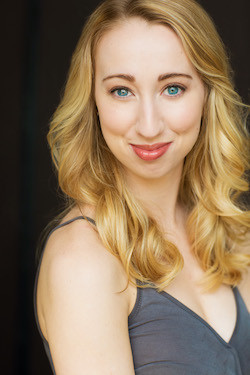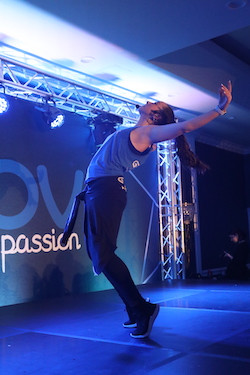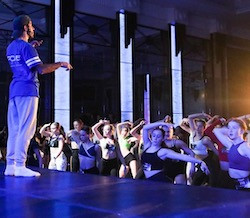It’s a familiar feeling for dancers: the house lights dim, the music swells, and you step onto the stage. The thrill is undeniable, but so is the pressure to perform flawlessly. Every dancer knows the sting of a mistake, whether it’s a forgotten step, a synchronization slip-up, or the dreaded fall. It’s easy to be self-critical, but how you handle these moments is what truly shapes you as a dancer.
To shed light on this common dancer’s dilemma, we spoke with judges and teachers from Groove Dance Competition and Convention, seasoned professionals who have witnessed countless performances and understand the ups and downs of stage life. They share their own experiences with on-stage mishaps and offer invaluable advice on turning disappointment into growth.
Ever Tumbled on Stage? Real Stories from Dance Pros
 Mallory Swanick demonstrating dance moves.
Mallory Swanick demonstrating dance moves.
Mallory Swanick, Groove Dance Competition judge and convention instructor, shares her own experiences: “Two falls come to mind immediately. Once, during a contemporary pointe piece, the stage had just been cleaned, and a section required me to slide en pointe across the stage. I found a patch that wasn’t completely dry and my supporting knee kissed the floor! It was so fast, I barely registered it. I just kept going for the remaining 15 minutes, shared a laugh with my choreographer afterward, and now I always double-check the stage surface! Another time, in my competitive days, I was doing a solo and mid-aerial, realized the transition was off. I ended up in an aerial to my knee! To this day, neither my choreographer nor I know how I recovered. I was frustrated with myself, not for falling, but for not having a conscious recovery plan in that split second. Let’s just say, I drilled that transition relentlessly the next week.”
Emma Gassett, dance educator and choreographer, recounts a humbling experience: “Dancing with the American Spirit Dance Company at Oklahoma City University, I fell during an aerial. My left foot slipped during a side aerial lunge, and I remember thinking, ‘This is going down!’ Next thing I knew, my shin and kneecap met the floor with a thud. It was incredibly humbling. I felt ashamed to fall out of a trick I’d done perfectly hundreds of times, especially as a professional dancer in front of an audience. But the show must go on. I got up and danced until the end of the piece!”
 Emma Gassett in a dance pose.
Emma Gassett in a dance pose.
Anthony Raimondi, faculty member and judge for Groove Dance Competition and Convention, offers a broader perspective: “Like any live performer, I’ve had my share of random stage spills, nothing too memorable. However, I vividly remember a performer falling during the West Side Story national tour when I was dance captain. During ‘Cool,’ she tripped over a set piece while everyone was moving downstage in unison. She was in the back, behind the set, and just waited there until the group moved back upstage, then popped back in seamlessly for the next phrase. It was brilliant improvisation, a split-second decision that made her fall virtually invisible.”
Lost the Beat? Staying in Sync on Stage
Raimondi elaborates on staying synchronized: “Countless times. In the moment, you feel exposed, like all eyes are on you. But honestly, the audience usually has no idea what’s right or wrong.”
Swanick adds, “I’m sure I’ve been out of sync more than I realize, but no specific performance moment jumps out. Dancers often have a general sense when the group timing is off, but the extent might not be clear until after the performance, maybe when reviewing video. I have tons of backstage memories of groups singing counts, going over changes affecting counts, and drilling counts and corrections right before curtain.”
Gassett recalls a moment of panic: “Performing a lyrical piece called ‘Tribute to Our Heroes’ at a dance competition around age 10, my mind just blanked. Time seemed to stop for me while everyone else kept moving. My teammates were transitioning formations, and I was completely lost, even though I knew the routine inside and out. Panic set in. Then, I took a breath, saw where everyone had moved, and got back into formation as quickly and discreetly as possible. I just kept telling myself, ‘Don’t panic, get back in sync.’”
 Mallory Swanick smiling.
Mallory Swanick smiling.
Bounce Back Stronger: Turning Mistakes into Motivation
It’s natural for dancers to be hard on themselves after a stage slip-up. What advice do these Groove Dance Comp experts have for dancers struggling with disappointment?
Swanick emphasizes perspective: “While a fall or mistake feels huge in the moment, it doesn’t define you as a dancer. Performances are the beautiful culmination of your hard work, but the journey leading up to the stage—your work ethic, focus, vulnerability, passion—that’s where the real value lies. If the process was rewarding, and your time on stage (minus that brief hiccup) was mostly fulfilling, call it a win. And if you can learn from it, even better!”
Gassett highlights resilience: “Life throws curveballs, on stage and off. We can’t control those moments, but we control our response. Take deep breaths to reset after a fall or choreography flub. We chase perfection in dance, but mistakes happen. Acknowledge that mishaps build resilience, making us stronger, smarter, more determined. We’re human; mistakes are part of it.”
Raimondi stresses the importance of moving forward: “Don’t dwell on mistakes, or they’ll erode your performance confidence. Dancers, myself included, are trained to strive for perfection, which fuels our studio work. But live performance is inherently imperfect. You’ll fall, you’ll mess up, you’ll have imperfect moments. What truly matters is your recovery. That dancer in West Side Story stood out not for falling, but for her intelligent, quick recovery, not for despair.”
Judging with Grace: Mistakes from a Judge’s Eye
How do judges at Groove Dance Competition view a dancer’s falls or mistakes? Do they deduct points? Mention it in critiques? Offer encouragement?
Raimondi explains his judging philosophy:
 Anthony Raimondi smiling.
Anthony Raimondi smiling.
“I rarely deduct points for falls or mistakes. I might acknowledge it, maybe suggest why it happened and how to prevent it in the future, but never penalize for the mistake itself. Performers need to learn that the show usually goes on, no matter what. Recovering well from those moments actually showcases a performer’s true capability, and that’s something I score positively.”
Swanick focuses on recovery: “It’s all about the recovery for me. I don’t fixate on falls or missteps; dancers train intensely, and mishaps happen. My feedback focuses on helping dancers avoid similar issues. Falls often stem from misused energy, force, or technical flaws in transitions or skills. I offer helpful tips in my critiques. Quick recovery and continuing the choreography earns commendation. If a dancer needs to exit due to injury, I commend their safety-conscious decision and offer encouragement.”
Gassett prioritizes safety and perseverance: “If a dancer falls, I want them to get up fast and keep going, unless injured. Never risk your health to finish a routine. If a fall causes severe pain, exit if you can, or stay down and wait for help. I never deduct points for falls; anything can happen live. I encourage dancers to keep performing with full energy until the end, unless seriously hurt.”
Turning Setbacks into Stepping Stones
How can dancers transform a discouraging moment like a stage mistake into a positive learning experience?
Emma Gassett teaching at Groove Dance Competition and Convention, inspiring the next generation of dancers.
Raimondi advocates for self-analysis: “Self-correction is crucial. Watch your performance videos, learn from mistakes. Be open to fixing them. Analyze your videos like a judge, pinpointing where things went wrong. This develops the skill to self-correct in real-time and become a performer who recovers quickly and intelligently.”
Swanick suggests reframing mistakes as challenges: “See falls or mistakes as challenges. A choreographer once told me to aim to fall out of pirouettes every time, but never in the same direction twice. 360 degrees in a circle, 360 potential fall directions – each fall teaches you how to correct yourself. The goal is to understand what falling feels like in every direction, so you ultimately know what perfect vertical alignment and balance feel like. I haven’t mastered 360 pirouette falls yet, but this challenge reminds me that falling isn’t shameful. Mistakes can spark new approaches to improvement. Each fall brings you closer to your goal.”
Gassett encourages proactive training: “Use frustration to fuel your training. Hit the studio, repeat the section where you faltered. Cross-train to strengthen muscles that support that section. Remember, everyone makes mistakes. You’re not alone. Move forward with a positive mindset! When life gives you lemons, make lemonade! Mess up on stage? Keep dancing! Often, the audience or judges won’t even notice! Don’t let frustration show or let it dampen your energy. Persevere and finish strong!”
By Laura Di Orio of Dance Informa.
